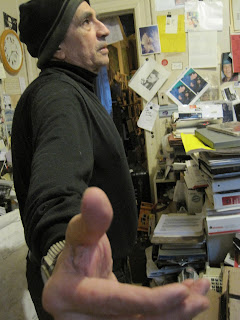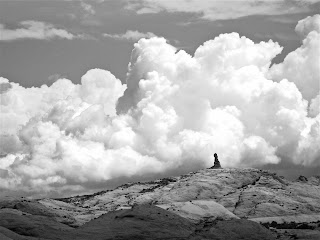Responding
to Hellman and Nusser
[Ed. Note: In response to my UBC column in the Telluride Watch Mar. 15th -- "Taking a hard look at nuclear energy", both Jeremy Hellman of Ouray and Rachel Nusser of Naturita wrote rebuttals. This week's column is my response.]
NUCLEAR …
Given Jeremy Hellman’s almost 40 years as a nuclear engineer and manager, it’s
no wonder he takes issue with my critical view of an industry that has given
us, not energy “too cheap to meter”, as promised, but disasters too
catastrophic to measure. Of course, in his mind, Chernobyl isn’t “relevant”. But for those in
Belarus who still are living with the many-thousand-year effects of that “black
swan” event (or Fukushima) as well as those of us wondering where the atomic
nightmare will strike again, the incredible cost of nuclear power gone awry
(not once but multiple times) should give all citizens pause … Hellman
dismisses the Price-Anderson Act as “hypothetical”, because taxpayers haven’t
had to make good on its unlimited-pay-out insurance policy (thank the goddess).
But without Price-Anderson, there would be no nuclear industry in this country.
The atom’s dirty little secret is that nuclear power produces energy too
expensive to insure. Forget that 60 years of technological advance has yet to
solve its malingering waste problem. Ignore its reactors’ inherent
vulnerability to terrorist attack …
| Radioactive Waste Buried At Idaho Labs (1969) |
Decades after it began, the industry still
hasn’t cleaned up its proliferation of past radioactive waste sites around the
country, as the recent New York Times
piece -- on the 683 abandoned mine sites on the Navajo reservation alone -- documented.
“Two days of exposure at the Cameron site would expose a person to more
external radiation than the Nuclear Regulatory Commission considers safe for an
entire year,” writes Leslie MacMillan. But as yet there are no warning signs or
even fencing at the Cameron site – a situation duplicated all over the West and
another hidden cost of an industry unwilling to face up to its dark underbelly.
So far the Department of Energy has paid out $60 million on assessment and
cleanup, but cleaning up all the sites would cost “hundreds of millions of
dollars” according to Clancy Tenley, a senior Environmental Protection Agency
official … Nor does Hellman mention the $1.5 billion taxpayers have paid out to
23,408 former uranium miners (or their families) who weren’t apprised of the
dangers of mining uranium and perished prematurely to cancer and related
illnesses. These are all costs that need to be calculated into any true cost
accounting of the nuclear energy option … Hellman may say renewable energy is
“wonderful to think about” but deeply flawed to meet the increasing demands of
the modern world, but I believe it’s the only way into the future, if we expect
our species to survive for seven more generations. Renewables, efficiency and
reduction of use – those are the keys to a resilient future energy policy …
And
as for Rachel Nusser’s commentary, I realize Nucla and Naturita have bet all
their chips on a new uranium mill. We know the hard times our West
End neighbors have endured, as long as I’ve lived here, and we
want to root for their economic success. But Nusser lost me in the second
sentence when she wrote, “The energy consumed by man is created by
non-renewable sources such as oil, gas, nuclear, and renewable resources [sic]”
… Yes, it’s true “Up Bear Creek” is an opinion column, not an environmental
impact statement, sagely weighing the pros and cons. Those have been done. I’ve
read them. And what I present here is the conclusion I’ve come to, as a Green
Party elected official, after 40 years of investigating this industry … And
yes, it’s also true all energy production has impacts. The point is, when
weighed apples to apples, the nuclear risk and its harm to the environment and
to the human race – men and women -- is clearly the most dangerous and
expensive of all energy alternatives.
 |
| Uche Ogbuji reading at the Karen Chamberlain Poetry Fest |
KAREN CHAMBERLAIN … Folks from all across the Western Slope flocked to Carbondale’s Thunder River Theatre Company last
weekend, where Valerie Haugen and Lon Winston organized the second annual Karen
Chamberlain Poetry Festival. Bards from all over the Western Slope dazzled
audiences with riveting performances by Aaron Abeyta of the San Luis Valley and
Bob King of Greeley’s Colorado Poets Center, Pike’s Peak Poet Laureate Jim
Ciletti, Seth & Collette of Denver with their “Triangle Man”, the
soft-spoken warrior Janice Gould, the well-played David Rothman, Grand
Junction’s Wendy Videlock, Fruita’s Danny Rosen, the incomparable Jack Mueller
of Log Hill Village, Uche Ogbuji, Kit Muldoon, Stewart Warren, Chris Ransick,
David Mason, Carol Bell, Debbi Brody, Rachel Kellum, Julie Cummings, Eric
Walter, Hildegard Guttendorfer, Western State’s WordHorde, Francie Jacober, Kit
Hedman, Kim Nuzzo, John Macker, Celeste Labadie, Peter Anderson, L. Luis Lopez,
Sandy Munro, the River City Nomads and more.
ADRIENNE RICH … Last week the nation lost one of its great poets. Rich’s Diving into the Wreck (1973) was one of
the seminal poem sequences of modern America. As a young man, I was
deeply moved by this book. In the section titled, “From the Prison House,”
speaking of violence against women, Rich wrote, “underneath my lids another eye
has opened” and this eye sees “the violence embedded in silence …”
THE TALKING GOURD
This eye
is not for weeping
Its vision
must be unblurred
though tears
are on my face
Its intent is clarity
It must forget nothing…
-Adrienne
Rich
-from Diving into the Wreck































